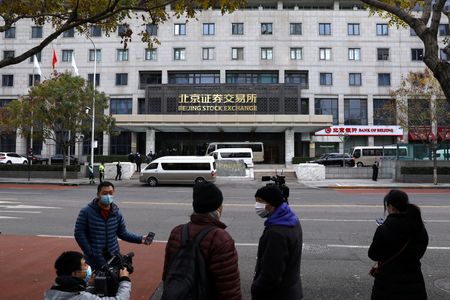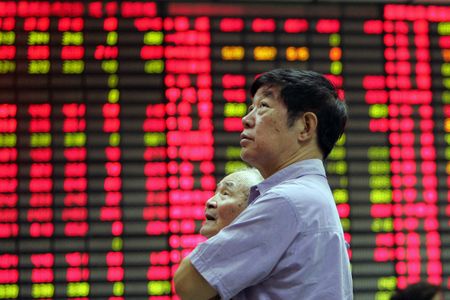(Reuters) -China’s ousting of its securities watchdog head on Wednesday drew a muted cheer from markets, with investors holding out for bigger measures that would tackle the root of the malaise gripping the world’s second-largest economy.
Yi Huiman was replaced as chairman of the China Securities Regulatory Commission, the CSRC, with Wu Qing, who has led the Shanghai Stock Exchange and served as a key deputy in Shanghai’s municipal government.
While no reason was given for Yi’s removal, it came after China’s stock market hit a five-year low on Monday and investors scrambled to cut their losses. Analysts and investors said the departure was a sign that policymakers were stepping up efforts to shore up battered Chinese markets.
So far, market-focused support moves such as restrictions on short-selling or reductions in trading costs, as well as government statements promising support, have helped stabilise but not reverse a rout.
The benchmark Shanghai Composite rose off Monday’s five-year low, up 1.4% on Wednesday, while the blue-chip CSI 300 Index added 1%.
The indexes were still down roughly 5% and 2.6% respectively this year, however, having fallen 13% and just over 15% over the last six months. In contrast, broader world stocks have rallied.
PROPERTY CRISIS
Chinese markets have been roiled by near constant turmoil since 2019, highlighted by the recent liquidation of indebted developer China Evergrande as a property crisis weighs on consumer sentiment and hampers a rebound from the COVID-19 pandemic.
“There is something more going on here than just a kind of a post-speculative episode, which may take actual policies to stop,” said George Magnus, research associate at Oxford University’s China Centre. “The market can certainly bounce but I doubt very much it would be durable.”
It wasn’t the first time China has fired a CSRC chairman during a market rout, analysts said, seeing Wednesday’s move as part of a drive to stabilise market sentiment.
“The China Securities Regulatory Commission has already been acting to try and shore up markets with curbs on short-selling, but this change at the top may be a signal that it is expected to go further,” said Lindsay James, investment strategist at Quilter Investors in London.
While noting Wu’s background as a securities regulator – previous CSRC chairmen have mostly been bankers – investors stressed that more needed to be done to ease market concerns.
LONG ROAD AHEAD
The International Monetary Fund last week revised up China’s 2024 growth estimate by 0.4 percentage points to 4.6% on increased government spending, though it was still slower than last year’s 5.2% expansion.
It said China could recover faster than expected if Beijing made additional property sector reforms, such as restructuring insolvent property developers, or spent more than anticipated to boost consumer confidence.
Geoffrey Yu, senior EMEA markets strategist at BNY Mellon, said the firm wanted to see fiscal as well as structural measures, especially support for households, which he said could be announced at March’s National People’s Congress – China’s annual parliament.
“We emphasize support for the households is essential for sentiment and this requires a broad-based effort from various layers of government.”
Such has been the sell-off in Chinese assets, however, that some investors note the country’s economic trajectory was better than current market valuations suggest.
China saw a $6.3 billion inflow into stocks in the week to Jan. 31, a BofA report citing data from EPFR said on Friday, following a nearly $12 billion inflow the previous week that was the most since 2015, as government efforts helped stabilise sentiment.
Yet the road to attract funds back is long, given more than $80 billion of outflows from China portfolios last year, according to Institute of International Finance estimates.
“On any measure, sentiment towards China is incredibly bearish at present,” Iain Cunningham, head of multi-asset growth at asset manager Ninety One, said in a note on Wednesday.
“We continue to see opportunities in businesses with structural tailwinds that have been performing well, and growing, in recent years, but trade at sale prices. The long-term outlook is more benign than current fears imply.”
(Reporting by the Global Finance and Markets team and Shanghai Newsroom; Writing by Yoruk Bahceli; editing by Dhara Ranasinghe and Alex Richardson)


